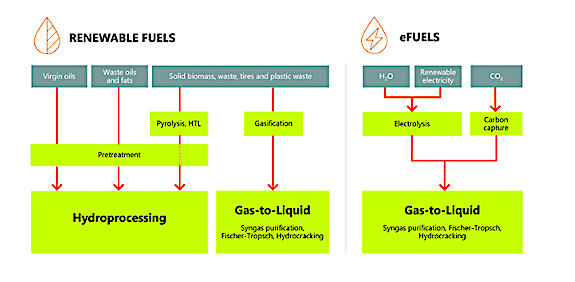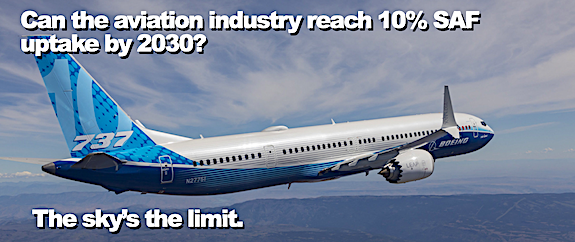Can the aviation industry reach 10% SAF uptake by 2030? The sky’s the limit.
From the Topsoe team
Special to the Digest
To achieve net-zero carbon emissions by 2050, the Clean Skies for Tomorrow Coalition has set a target of 10% SAF adoption by 2030. For fuel producers, that means creating enough supply to meet future demand, and for the aviation industry, it means taking the leap and making real, tangible change. And though we may face some turbulence along the way, the forecast looks sunny.
If we talked about sustainable aviation fuel (SAF) only a year ago, it was clear to see our collective ambitions far outweighed our collective efforts. Indeed, if we look back to 2019, SAF accounted for only 0.1% of global jet fuel consumption. Which has made it all the more exciting to see airlines starting to bring SAF into the mix.
In 2021, airlines purchased every single drop of SAF available, regardless of the price difference compared to conventional jet fuel. And to date, more than 450,000 flights have been powered by SAF, with the world’s first 100% SAF-powered commercial test flight taking off – and landing – in Sweden in June 2022.
And while this puts us on the right path to decarbonizing aviation, cost, differing legislations, and having enough feedstock to convert into SAF all pose a challenge.
However, we can get there – and it can be done.
From “if” to “when”
To understand the steep upward trajectory of SAF adoption in aviation, we must further explore the factors that got us where we are today. As mentioned, ambition has not been an issue, especially if you consider the Clean Skies for Tomorrow Coalition’s goal of 10% by 2030.
But SAF is expensive. In some instances, up to five times the cost of conventional jet fuel. And though this hasn’t stopped the aviation industry from making moves, with airlines like Airbus and Boeing publicizing their goals, the reasons for SAF’s slow uptake are understandable.
And where legislation can play a large role.
Destination: greater SAF accessibility
In the US, the Biden administration’s recent Inflation Reduction Act means various sectors, including the biofuels industry, can now benefit from using and producing more sustainable products.
And in the EU, the European Commission’s ‘Fit for 55’ package aims to reduce net greenhouse gas emissions to at least 55% by 2030. What’s more, the package, introduced in 2021, includes the EU’s most solid legislation on SAF to date. Called the ReFuelEU Aviation initiative, the goal of this mandate is to create enough supply and demand for SAF to meet regional climate targets.
It’s time to fasten your seatbelts
As we can see, the necessary legislation is starting to emerge, which is great news considering the technologies we need are already here. And of the seven approved pathways to SAF production currently available, we have identified the main routes we consider to be the most commercially advanced.

Firstly, we have hydroprocessing which enables the processing of virgin oils, waste oils and fats, solid biomass, and plastic waste/tires into HEFA-based SAF with minimal Carbon Intensity (CI) compared to traditional petroleum aviation fuel.
But if gasified waste is your source of choice, you can go the synthetic- and gas-based route with Gas-to-Liquid from renewable feedsstocks. This commercially proven technology utilizes syngas, hydroprocessing and Fischer-Tropsch technologies to produce Fischer-Tropsch Synthetic Paraffinic Kerosene (FT-SPK).
And then there is Gas-to-Liquid which allows you to produce eFuels from renewable energy via green hydrogen and from CO2 via carbon capture. By combining synthesis gas, Fischer-Tropsch and hydroprocessing technologies, this route produces FT-SPK/eJet and green naphtha.
As the market for and production of SAF increases, so will the need for suitable feedstocks. There are many reasons for this, not least of which is that other segments and industries are also pursuing the same feedstocks for their own purposes, like road transport, marine fuel, and petrochemicals. That can become a seriously limiting factor in our journey to decarbonizing aviation.
Inbound: advanced feedstocks
But there is great news, and that news is– that third-generation feedstocks are coming. Advanced solid waste feedstocks that can be derived from:
– solid biomass waste,
– rotational crops; and
– recycled carbon.
The processes for working with solid waste feedstocks naturally differ from those applied to first- and second-generation feedstocks. The principal divergence being solid-to-liquid conversion. And while the technologies for this conversion process are almost ready and the knowledge is there, strict aviation regulations mean these processes still need approval.
Solid waste feedstocks are a much more abundant resource than previous generations and will remain in the years to come. In all, their emergence is a thrilling development — and key to decarbonizing aviation.
Boundless opportunities, endless excitement
There’s no doubt about it; the demand for SAF will keep growing. And that makes it a tremendously exciting industry to be involved with.
With innovative technologies and cutting-edge knowledge enabling the upgrading of advanced feedstocks, fuel production is at the center of the global transition. And forward-thinking businesses will capture this by moving into new, advanced feedstocks while the opportunity is ripe.
Let’s steer into the future – together
This may sound like a lot to overcome, but we have a secret weapon at our disposal- collaboration. Across industries, governments, and investors. And we’re already seeing how impactful it can be, with refineries and investors working alongside governmental bodies, researchers and so on to get us to a point where SAF is produced on a commercial scale. It’s also thanks to collaboration that we are seeing more investment in the infrastructure needed to get us across the finish line.
Above all, we must be courageous. We are all responsible when it comes to decarbonizing the aviation industry. And the more we work together, the clearer our (flight) path will be.
Category: Top Stories, Thought Leadership
















